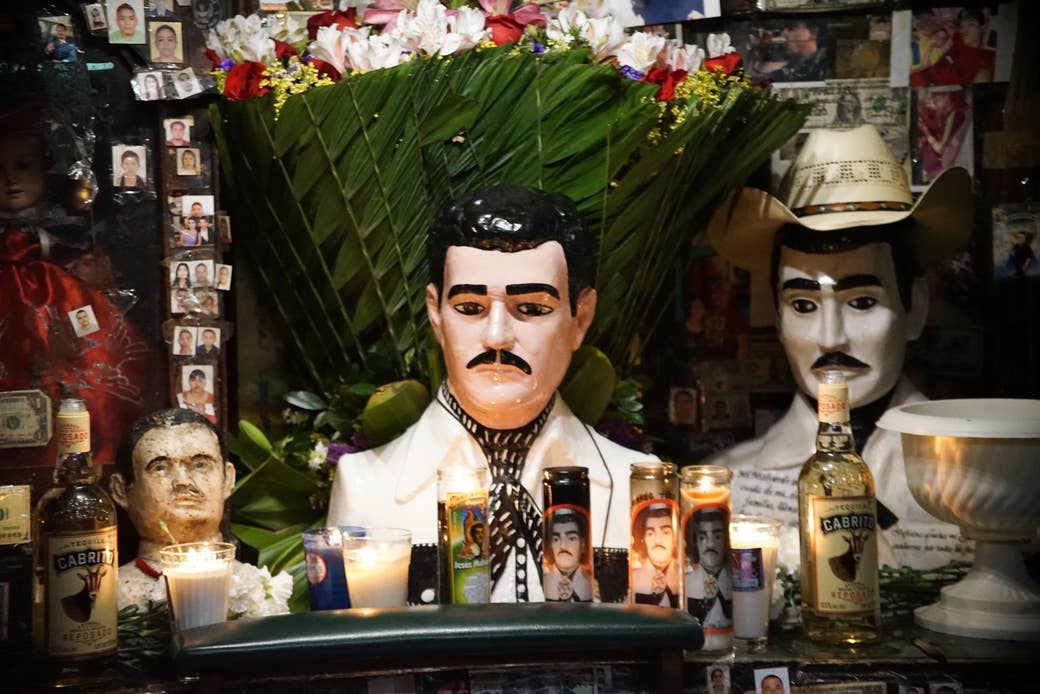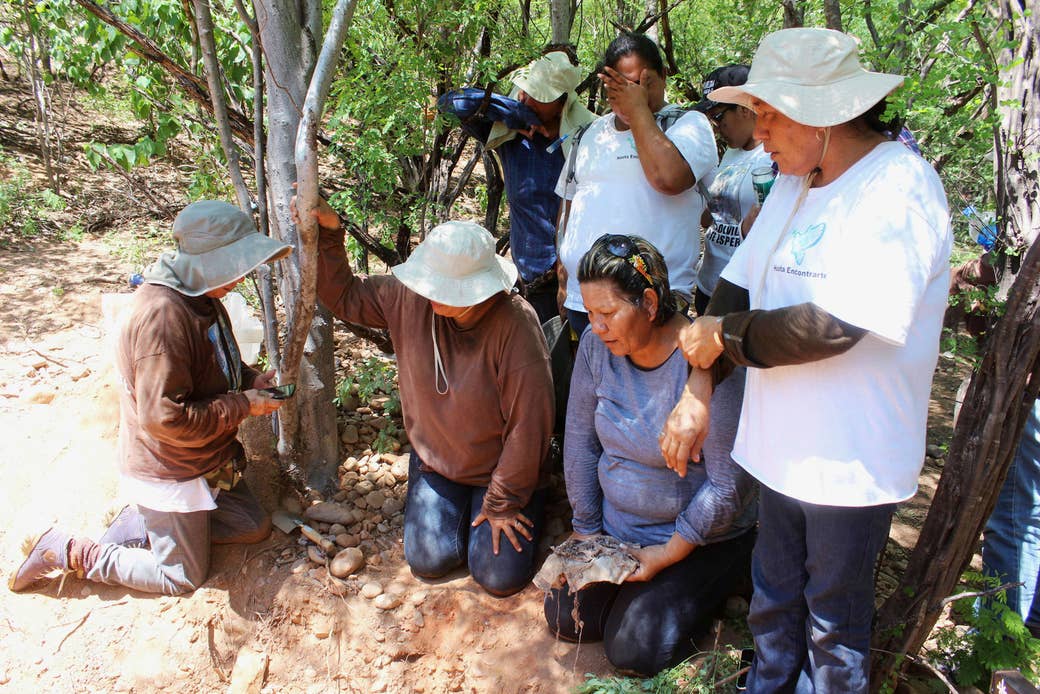
In July 2014, Mirna Medina Quiñónez was looking for her son. Like hundreds of others in the state of Sinaloa, Mexico, he had recently gone missing, with few to no clues left regarding his whereabouts or safety. After being told by police authorities of the El Fuerte Municipality that they did not conduct searches for missing people, Medina Quiñónez decided to take matters into her own hands, beginning a pursuit that would eventually be joined by hundreds of other mothers of the region whose own children had suddenly vanished.
The word “desaparecido,” in Spanish, has an exact translation: “disappeared,” though in English the word is used as a verb. For Mexicans, “desaparecido” is very much a noun, employed in countless headlines and everyday conversations. Los desaparecidos — the disappeared — describes the men and women who simply go missing, de un día para otro — from one day to the next — in a country that for many decades has been an epicenter of drug trafficking, the main route for illegal substances passing through on their way to the United States.
Medina Quiñónez found the remains of her son, Roberto Corrales, three years after she began her tireless search, which by then had transformed into something much larger than one mother’s solitary grief. The women who had joined her years earlier to search for their own disappeared family members formed a group, going by the name Las Rastreadoras de El Fuerte. In the face of local authorities’ indifference, they armed themselves with shovels and ice picks and began scouting the Sinaloan mountains for clandestine burial pits in the hopes of identifying the discovered human remains as one of their own.
It’s almost too eerie to be real, isn’t it? An army of grieving mothers, trekking through fields, searching only for corpses, because seeking any semblance of justice would be too unrealistic an ambition.

I’ve been haunted by the thought of these women for months now. I can’t get them out of my head. When I was growing up in Sinaloa, in a city called Culiacán, I would often think of the phrase “reality is stranger than fiction.” The city, which is also the capital of the state, is widely known for being the cradle of narcoculture, a place where the operations of drug cartels are deeply entrenched in the local folklore. It’s not that everyone there is involved in the illicit activities of drug trafficking; it’s just that everyone is aware of them, and many people take pride in their close proximity.
“Don’t honk your horn at anyone,” my dad instructed me when I was learning how to drive. “You never know who could be in the other car.”
Corridos — songs dedicated to well-known drug lords, exalting their conquests and exploits — blare from trucks with dark tinted windows as they make their way through the streets. Waves of violence come and go, but the feeling of impending danger is perpetual. “Don’t honk your horn at anyone,” my dad instructed me when I was learning how to drive. “You never know who could be in the other car.”
My deep belief that the quotidian events of my life were far more bizarre than what any fictionalized version of them could portray was the main reason I never watched any movies or shows focused on drug cartels — not Sicario, not Savages, not La Reina del Sur. I was immune to their shock value, not far enough removed from the consequences of the reality they depicted to be entertained, even after I moved to Guadalajara for college in 2010, and later Mexico City. I suppose I was also not involved enough in the culture to feel represented or validated or seen. At best I felt disinterested, at worst, angry at the glorifying lens through which the world was acquainting itself with the cartels that ruled my city.
I’m not alone in rejecting these idealized depictions. “They’re commercializing tragedy, and it’s not historic,” said Carlos, a man I spoke to whose brother was abducted years ago, a few miles outside of Culiacán (I’ve changed his name, at his request). “It’s still unfolding here every day, and these shows don’t signal social problems. They create idols.” What’s most curious, he says, is that “the stories told are usually from the perspectives of criminals or authorities — no one else’s.”

Last November, after three successful seasons of its hit series Narcos, Netflix rolled out a fourth installment of the show, this time set in 1980s Mexico. And sure enough, the story begins in Sinaloa, on the outskirts of Culiacán. It’s almost surreal to me to see this small world I grew up in — the thick Sinaloan accent, the coexistence of rural poverty and exorbitant wealth, the casual commodification of women, the corruption of law and order — now front and center for the rest of the world to consume as entertainment.
And for the first time, I decided to watch — in an attempt, as morbid as this will sound, to alleviate a particularly strong pang of homesickness. But whatever I was hoping to find, it wasn’t there. Despite a majority Latino cast and a hefty amount of Spanish, I would say Narcos: Mexico is a show that, like its predecessors, is built to deliver exactly what US audiences want to see when they peek into the illicit world of drug trafficking. It is a story that is essentially about both an underdog and a visionary, a business-savvy Man in a Suit, who hoodwinks the government until he has to bribe the government, amassing a fortune and the submissive respect of his peers along the way.
Recent decades have seen the rise of arbitrary abductions and killings in the regions of Mexico that host the country’s leading cartel headquarters; much of the violence is as nonsensical as it is brutal, and yet the myth of the benevolent drug lord persists beyond Mexico’s borders. It’s a neat narrative to produce and consume, and America, it seems, loves neat narratives.
Narcos: Mexico tells the story of how, decades ago, Miguel Ángel Félix Gallardo (played by Diego Luna) managed to go from lowly police officer of the then-underdeveloped state of Sinaloa to the country’s most powerful drug kingpin. As he was rising to power along with his associates, Rafael Caro Quintero (Tenoch Huerta) and Ernesto Fonseca Carrillo (Joaquín Cosío), the American Drug Enforcement Administration agent Enrique “Kiki” Camarena (Michael Peña) worked undercover to foil their operation. The season ends with Camarena’s brutal abduction, torture, and murder at the hands of the cartel, a true event that prompted what is still one of the largest homicide investigations ever conducted by the US government in North America.
Mexico’s social fabric is fraying. This is the sort of truth that gets lost in shows such as Narcos.
Luna, for all his acting chops as the show’s main capo, does a noteworthy job fucking up the Sinaloan accent, but by far the most irritating voice in the show is the distinctly American narrator’s (Scoot McNairy). Cutting inopportunely into the plot (the narrator has been a divisive fixture of Narcos since the beginning), his profanity-ridden monologues serve as constant reminders that the story being told is, above all, supposed to be entertaining.
I mean, I get it. It’s a show, and shows are made to entertain. Decades of successful mafia movies have proven that the subject rarely fails to entice audiences who live in no real proximity to violence; the suburban dad who loves The Godfather, the white dude with a Scarface poster tacked to his dorm room wall. Though Narcos: Mexico (which has already been renewed for a second season) is based on true events, its delivery is stalely formulaic, and it seems wholly uninterested in exploring anything beyond the tired tropes of the genre.
Last September, the news of an 18-wheeler truck near Guadalajara carrying nearly 200 corpses stunned the country. It was confirmed that local authorities, facing no space in the morgue for new arrivals, had ordered the bodies be dumped in the trailer and driven aimlessly through the city’s periphery. Octavio Cotero, then-director of the Forensic Science Institute of Jalisco, claimed that there are at least 20 other states battling similar storage problems. The country has 32 states. Mexico’s social fabric is fraying. This is the sort of truth that gets lost in shows such as Narcos.
Reality is stranger than fiction. It is also certainly and infinitely more complex.

Lately I’ve been feeling strangely protective of Mexico. I try to explain the nuance of this surreal country to every foreigner I encounter, with an urgency that surely comes across as unwarranted. No, it’s not like what you think at all, it’s not as bad, but also, it’s so much worse. What am I trying to say? Why does it feel so imperative?
The harrowing violence that takes place in Mexico isn’t exactly lacking coverage in US media. The United States’s sitting president basically launched his campaign off of it. What’s curious to me is how that violence can simultaneously occupy two opposing narratives. One is the phantom threat of Mexicans as rapists, murderers, and monsters messily flowing into the US, bringing drugs, bringing crime. At the same time: the Man in a Suit. His flair for business, the justified murders, the complicit governments.
In Narcos: Mexico, Félix Gallardo, whose nickname was El Padrino (“The Godfather”), is shown to be an elegant and calculating executive. He protests Camarena’s abduction, and giving the order for his murder seems to weigh on his conscience. It plays well into the narrative that has been crafted by American media about mafia characters — men who don’t mess with anyone who doesn’t mess with them.
Joaquín “El Chapo” Guzmán’s trial began last November in Brooklyn around the same time that Narcos: Mexico premiered. The alleged former leader of the Sinaloa Cartel has escaped from Mexican prisons twice, and was extradited to the United States in 2016 following his third arrest.
He is revered — or at least obsessed over — on both sides of the border. In Sinaloa, Chapo merch abounds, and a march held in the state’s capital demanding his release after his apprehension in 2014 was attended by thousands. In the US, his trial has become something of a tourist attraction, drawing crowds of people to gather outside the courthouse, eagerly awaiting a glimpse of the defendant, all 5 feet 6 inches of him.
A friend who recently visited New York told me there are cartoonists in Times Square quickly drawing El Chapo’s portrait and offering it to amused passersby. Vice has produced eight episodes of a podcast — in English and Spanish — covering his trial, which you can listen to on Spotify, iTunes, or YouTube. Its host, Keegan Hamilton, has been live-tweeting the proceedings with an enthusiasm that conveys his deep fascination with not just this case, but cartel operations in general. There’s something about the language he uses that reminds me of the wide-eyed expressions of excitement in my American friends’ faces when I tell them about my hometown.
“Sometimes I feel the media has overexposed him,” Emma Coronel Aispuro, Guzmán’s wife, told Telemundo recently. “I feel people created an image of him and they want that image to remain in the public’s consciousness. It’s the image that sells.”
I’ve been surrounded by the mythology of drug lords all my life. The truth is, it is fascinating. I wouldn’t be writing this if it weren’t. It’s worth remembering, though, that the legend is still fiction.
There is no glamour to murder, no glory in gore. The trafficking systems are less sophisticated than one would imagine, the brains behind the operations less sharp and calculating. For every philanthropic deed by a cartel in a rural town, there are countless people abducted and murdered. Actually, they’re not countless. There is an exact number of them, and every day it grows. They’re the children of the women weeping in fields, the afterthought in shows like Narcos.
I looked online for hours, but I never did find a photograph of Joaquín Guzmán in a suit. ●
Ana Karina Zatarain is a writer living in Mexico City.
